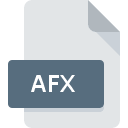.AFX File Extension

Auto FX PhotoGraphic Edges Image
| Developer | Auto FX Software |
| Popularity | |
| Category | Raster Image Files |
| Format | .AFX |
| Cross Platform | Update Soon |
What is an AFX file?
The AFX file extension is primarily associated with Auto FX Software’s PhotoGraphic Edges, a popular tool used by photographers and graphic designers to enhance and stylize images with various edge effects.
AFX files store image data that includes these effects and configurations applied within the software.
More Information.
PhotoGraphic Edges was introduced to provide photographers and designers with a comprehensive set of tools to add artistic and professional-looking edges to their digital images.
The AFX file format was created to preserve these enhancements in a non-destructive manner, allowing users to easily apply and modify edge effects without altering the original image data.
Origin Of This File.
Auto FX Software developed PhotoGraphic Edges as a plugin suite for Adobe Photoshop and other image editing software.
The AFX format emerged as a proprietary file type specifically designed to retain the intricate edge effects and enhancements created using the software’s tools.
File Structure Technical Specification.
AFX files are structured to store not only the enhanced image data but also metadata related to the applied effects. The technical specifications of AFX files include:
- Image Data: The main content of the file, including the base image with applied edge effects.
- Effect Parameters: Settings and configurations used to achieve specific edge effects, such as textures, borders, and overlays.
- Metadata: Information about the software version, settings, and any other relevant details necessary for rendering the image correctly.
The file structure ensures that all applied enhancements are stored in a format that allows for easy editing and reapplication.
How to Convert the File?
Since AFX files are specific to Auto FX Software’s PhotoGraphic Edges, converting them to other formats might involve exporting the image with applied effects to more common formats like JPEG or PNG. Here’s how you can convert AFX files:
- Export within PhotoGraphic Edges: Use the export feature within the PhotoGraphic Edges software to save the image with applied effects in formats like JPEG, PNG, or TIFF.
- Manual Export in Photoshop: If using PhotoGraphic Edges as a plugin in Photoshop, you can export the image with effects directly from Photoshop’s export options.
- Third-Party Conversion Tools: Some third-party image conversion tools may support conversion from AFX to other image formats, though results may vary.
Advantages And Disadvantages.
Advantages:
- Enhanced Creativity: Enables users to add sophisticated edge effects to images, enhancing creativity and visual appeal.
- Non-Destructive Editing: AFX files preserve the original image data while allowing for extensive modifications to the applied effects.
- Compatibility: Works seamlessly with major image editing software, including Adobe Photoshop, due to its plugin nature.
Disadvantages:
- Proprietary Format: AFX files are proprietary to Auto FX Software, limiting interoperability with other software and platforms.
- File Size: Depending on the complexity of effects applied, AFX files can be larger in size compared to standard image formats.
How to Open AFX?
Open In Windows
- Use Adobe Photoshop with the PhotoGraphic Edges plugin installed to open and edit AFX files.
- Alternatively, open AFX files within the standalone PhotoGraphic Edges application if available.
Open In Linux
- Limited native support exists; consider using Wine to run Adobe Photoshop or explore alternative software options that support Photoshop plugins.
Open In MAC
- Similar to Windows, use Adobe Photoshop with the PhotoGraphic Edges plugin or the standalone PhotoGraphic Edges application to open and edit AFX files.








